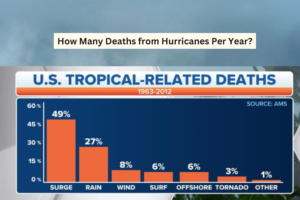How Many Deaths from Hurricanes Per Year?
Hurricanes are among the most destructive natural disasters, causing significant damage to infrastructure, property, and human life. One key question that arises frequently is, “How many deaths from hurricanes occur per year?” In this article, we’ll explore hurricane-related fatalities, how these numbers have changed over time, and the factors influencing these trends.

Overview of Hurricane Fatalities
The number of deaths from hurricanes varies greatly depending on the storm’s intensity, size, and the region it impacts. According to data from the National Oceanic and Atmospheric Administration (NOAA), hurricanes cause an average of 46 deaths per year in the United States. Globally, the death toll from hurricanes, typhoons, and cyclones (all different names for the same weather phenomenon in different regions) can reach into the hundreds or even thousands in particularly severe years.
Historical Trends in Hurricane Fatalities
Historically, hurricane fatalities were significantly higher before the advancement of meteorological technology. In the early 20th century, hurricanes such as the Great Galveston Hurricane of 1900, which caused between 6,000 to 12,000 deaths, were not predicted in advance, resulting in high death tolls.
However, with modern warning systems, satellite tracking, and emergency preparedness measures, the number of deaths caused by hurricanes has decreased over time, despite the increase in storm frequency and intensity.
For example:
- Hurricane Katrina (2005): Despite being a well-predicted storm, Katrina resulted in around 1,836 deaths, largely due to the failure of flood defenses in New Orleans and slow evacuation processes.
- Hurricane Maria (2017): Maria caused around 2,975 deaths in Puerto Rico, most of which were attributed to the aftermath, such as lack of electricity, healthcare disruptions, and clean water shortages.
These events highlight that while early warnings can reduce direct fatalities during the storm, the aftermath often contributes to additional deaths.
ALSO READ The Rise of Meghan Markle and Prince Harry: Royal Departure
Factors Influencing Hurricane Deaths
Several factors influence the number of deaths caused by hurricanes each year:
- Storm Intensity and Category: The stronger the storm (higher category hurricanes, such as Category 4 or 5), the more likely it is to cause fatalities due to higher wind speeds, storm surges, and flooding.
- Population Density in Affected Areas: Coastal regions with high populations are more vulnerable. Urban centers like Miami, New Orleans, or Houston are at greater risk because more people live in the path of these storms.
- Preparedness and Response: Death tolls are often mitigated by timely evacuations and emergency responses. Countries with better infrastructure and disaster preparedness tend to experience fewer deaths, even from severe storms.
- Geography: Low-lying regions and islands, such as those in the Caribbean and Southeast Asia, often experience higher death tolls due to storm surges, flooding, and difficulty in evacuating residents.
- Aftermath and Infrastructure Damage: While deaths during the storm are often reported, fatalities can also result from post-storm conditions like lack of clean water, medical care, and food.
Recent Yearly Data on Hurricane Fatalities
Let’s look at some recent data for hurricane-related deaths in the United States:
- 2020: A record-setting Atlantic hurricane season saw 86 deaths directly attributed to hurricanes and tropical storms, with an additional 47 deaths indirectly related to storm impacts.
- 2019: The hurricane season resulted in around 15 direct fatalities in the U.S., with Hurricane Dorian being a significant storm, though the Bahamas suffered far greater losses.
- 2018: Hurricane Michael and Florence were the major storms, causing 74 deaths combined in the U.S.
- 2017: One of the deadliest seasons in recent history, hurricanes like Harvey, Irma, and Maria contributed to a combined death toll of 3,361 when considering both direct and indirect causes, including Puerto Rico’s long recovery from Hurricane Maria.
Globally, the death toll from cyclones, hurricanes, and typhoons is harder to estimate due to varying reporting standards. However, during major events like Typhoon Haiyan (Yolanda) in 2013, which struck the Philippines, the death toll exceeded 6,000.
Long-Term Trends and Projections
While hurricane fatalities have decreased in regions with advanced warning systems, global climate change is contributing to stronger storms and higher storm surges. This may increase the potential for higher death tolls in future storms, particularly in vulnerable areas.
The Intergovernmental Panel on Climate Change (IPCC) has indicated that rising sea levels, increased temperatures, and more frequent extreme weather events will likely lead to stronger hurricanes. Although improved preparedness and response measures can help reduce fatalities, the risk remains high, particularly for low-income regions and small island nations.
How to Reduce Hurricane Deaths
Efforts to reduce the number of deaths from hurricanes have focused on a combination of early warning systems, better building codes, and improved evacuation plans. Some key strategies include:
- Enhanced Forecasting: NOAA and other meteorological agencies continue to improve hurricane tracking and prediction models, giving people more time to prepare.
- Infrastructure Investment: Stronger levees, storm surge barriers, and flood defenses can help reduce the impact of hurricanes, particularly in low-lying areas.
- Public Awareness Campaigns: Educating the public on the importance of evacuation and storm preparedness can save lives, particularly in regions with high hurricane risk.
On average, hurricanes cause around 46 deaths per year in the U.S., with fluctuations based on storm intensity and location. While modern technology and preparedness measures have significantly reduced hurricane fatalities compared to the early 20th century, the potential for deadly storms remains, especially in regions with vulnerable populations and infrastructure.
Continued investment in forecasting, emergency planning, and infrastructure resilience is essential to mitigating the future impact of hurricanes and saving lives.
FAQs
- How many deaths are caused by hurricanes each year in the U.S.? On average, about 46 deaths are caused by hurricanes in the U.S. annually, but this number can vary depending on the intensity of the storms.
- What was the deadliest hurricane in U.S. history? The Great Galveston Hurricane of 1900 was the deadliest, with an estimated 6,000 to 12,000 deaths.
- Why are modern hurricane death tolls lower than historical events? Advances in technology, forecasting, and emergency preparedness have helped reduce death tolls in recent decades.
- How do hurricanes cause fatalities? Hurricanes cause fatalities through storm surges, high winds, flooding, and indirectly through post-storm conditions like lack of clean water, healthcare, and food.
- Which recent hurricanes caused the most deaths? Hurricanes Maria (2017) and Katrina (2005) are among the deadliest in recent years, with fatalities reaching into the thousands.
- How does climate change affect hurricane fatalities? Climate change may lead to more intense hurricanes, raising the potential for higher death tolls, especially in vulnerable regions.




